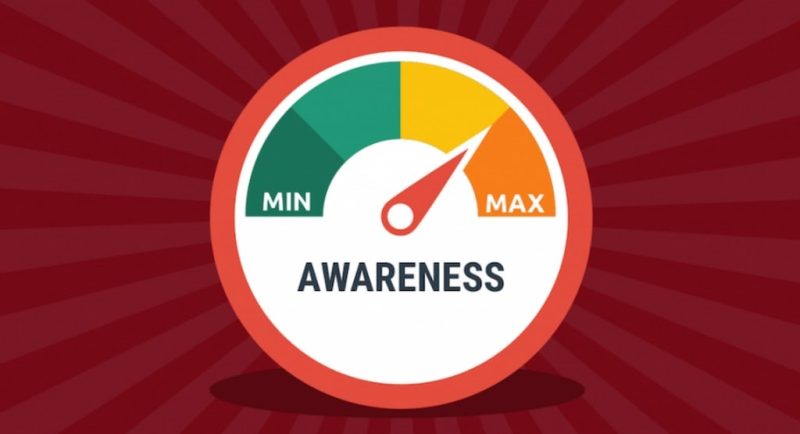

This post will help you gain control over your emotions, by increasing your emotional awareness, giving you strategies to regulate your emotions, and showing you how to ultimately use this emotional control to your advantage.
Specifically, we will give you:
- Tools that will help you become more aware of your emotions
- Strategies that will help you exert more control over your emotions
- Guidelines on how to use your knowledge of emotions in order to improve your work-life
To start off, the first blog post will tackle emotional awareness. You might ask yourself how being aware of your emotions might benefit you.
Studies have shown that being more aware of your emotions is linked to:
- Lower levels of social anxiety
- Better relationships with friends and family
- Higher self-esteem
- Lower levels of depression
As always, our team of experts in neuroscience and psychology have gone through over 50 scientific studies related to emotions, emotional awareness and emotional intelligence, to provide you with this detailed, science-based guide on how to control your emotions through emotional awareness.

Understanding when and why emotions occur
Emotions play an important role in how we perceive and interact with our world. They can improve our lives for instance by:
- letting us experience fear that stops us from doing potentially dangerous things (walking too close to the edge of a cliff)
- making us experience happiness that reinforces newly made friendships
- letting us experience anger that propels us to fight for causes that we care about.
However, when emotions have the wrong intensity, duration, frequency, or type for a particular situation, they can also be very harmful to us. Think for instance of:
- Anger that lead us to hurt oneself or a loved one
- Fear of commitment that leads to broken relationships
- Anxiety that cripples your social and worklife
It is because of these unhelpful instances of emotions that it is beneficial to put effort into trying to control your emotions. Before we can try and exert this control, we first have to increase our emotional awareness, so that we will be more perceptive of the emotions that we are experiencing.
The first step in our journey to increase emotional awareness, is to take a closer look at what an emotion exactly is.

What is an emotion
From a scientific point of view, an emotion is:
- An intense and short-lived feeling,
- Caused by an evaluation of an (real or imagined) event that is of important concern,
- Preparing the body to react or pay attention to the events
Regardless of which of emotion (e.g. anger, joy, sadness, etc.) you might experience, every emotion consists of five main components, where each have a distinct function.
Here are the 5 components that construct an emotion and their function
- Cognitive — Evaluate the event that leads to the emotion
- Neurophysiological – Prepares your body to react to the event
- Motor expression – Expresses, or communicates your reaction to the event and how you will behave
- Motivational – Prepares and directs your response toward the event
- Subjective feeling – Monitors how your body feels in light of the event that is happening
- breakdown of emotions

Let us try two exercises in order to give you a firm understanding of how these components actually work in practice. You can also learn more about 4 scientific ways to improve your emotional intelligence for higher outputs.
Exercise 1: Past emotional event
To start off, think of the last time that you clearly felt an emotion. It doesn’t matter which emotion you think of, as long as you have a clear (or as clear as possible) memory about the situation in which you experienced the emotion.
If you have a memory in your head, then we can start dissecting the situation and analyze it using these five components.
Step 1: The cognitive component of an emotion
The cognitive component of emotion consists of the evaluation of the event that leads to the emotion. It is the “why” part of the emotion. So try and think back of the moment you experienced your emotion. Can you remember the event that caused it? Ask yourself:
- How was the event different from what you expected it to be at the moment?
- How likely was it that the event would bring you negative (or desirable) outcomes?
- How important was the event to your goals or needs at the time?
- Was the event caused by yourself, or by somebody else?
Could the consequences of the event, at the time, have been avoided, or modified to your advantage?
Zoning in on the why of the situation will give you valuable information on what triggers these kinds of emotions for you. Knowing the trigger will increase your emotional awareness, as it will let you predict your future behavior, and how you might adjust your situation in order to elicit (or prevent) the (un)desirable emotion.
Step 2: The neurophysiological component of an emotion
Let’s continue with the second component. The neurophysiological component of emotions are the bodily symptoms that you experience during emotions. It is the process your body starts in order to prepare you, or make you aware of the event that you are experiencing. Think back at how your body was acting when you experienced your specific emotion. Were you:
- Getting pale, or blushing
- Feeling cold shivers, or feeling warm (pleasant)
- Heartbeat slowing down, or getting faster
- Breathing slowing down, or getting faster
- Muscles tensing, or relaxing
Not everybody experiences emotions the same way. A good way to increase emotional awareness, is to try and determine for yourself which emotions are linked to which bodily reactions. Knowing the pattern of changes will increase the chance of accurately perceiving the emotion you are experiencing.
Step 3: The motor expression component of an emotion
Now let’s take a look at the motor expression component of emotions. This component consists of the changes in facial and vocal expression, or bodily movements caused by the emotion. In other words, it is the way your body responds towards the event, in order to communicate or express how it’s feeling at the time. Please try and think back on how your body language changed due to the event. Were you:
- Smiling, or frowning
- Moving towards, or withdrawing from people or things
- Moving abruptly, or freezing in one place
- Eyes opening, or closing
- Voice volume increasing, or decreasing
- Voice being assertive, or trembling
Similar to the previous component, knowing how you vocalize your emotion will not only help you increase your emotional awareness, but also give you insight into how you come across to other people. Do you for instance raise your voice when you are angry, or do you go quiet and stay silent in your anger. Once you know your behavior, you can ask yourself, “Is this the way I want to convey my anger”. Knowing it will help you control your emotions, and help you refine your external behavior.
Step 4: The motivational component of an emotion
The next component is the motivational component of emotions. This component consists of the action you take in order to prepare and direct your attention toward the situation. Thinking back to your situation. Did you:
- Move your attention towards, or away from the event
- Direct your attention towards yourself, or towards others
- Physically move yourself towards, or away from the event.
Awareness of your automatic behavior increases the possibility of adjusting this behavior towards behavior that is better suited for the situation.
Step 5: The subjective feeling component of an emotion
The subjective feeling component of emotions is the component that makes each emotional experience different from the other. Try and think:
- How intense was the emotion?
- How long did the emotion last?
- How good or bad was the emotion?
- How much arousal did the emotion bring forth?
More importantly, try and think of why you experienced the emotion the way you did.
- Why was the emotion as intense as it was?
- Why did the emotion last as long as it did?
- Why was the emotion good or bad?
- Why was I so aroused by the emotion?
You can use this information to gauge how important an event is. Did you for instance get angrier than you expected when your coworker did not respect his deadline? Why do you think you got that angry? Or inversely, why didn’t you get angrier? You can use your emotional awareness to reflect upon your emotions, which help you gauge how your current situation might hold up against your ideal situation.

Exercise 2: Upcoming emotional event
Now that we have dissected and analyzed a past emotion, it is time to push it up another level. As we’ve mentioned earlier, emotions are not only elicited by physical, or real situations, but also by imagined situations. The important part is that the situation is of great concern to us and is anchored in reality, meaning that it has a high likelihood of actually happening.
Think, for instance, of that important meeting you are going to have, or that big presentation that you have to give in front of the board of directors. It doesn’t even have to be work-related. You might have that date with that cute girl, or guy, coming up, or meeting with the in-laws for the first time. It doesn’t matter what the situation is, as long as it is important to you.
Let’s do the same exercise again with an upcoming, important event. This time, instead of thinking about how you would feel, try and be aware of how you are feeling right now.
Following the same steps, we will first look at the cognitive component. Why is this event making you feel emotional?
- How was the event different from what you expected it to be at the moment?
- Is it likely that the event will bring you negative (or desirable) outcomes?
- How important is the event to your current goals or needs?
- Is the event caused by yourself, or by somebody else?
- Can the consequences of the event be avoided, or modified to your advantage?
Next, let’s try and really look at how your body is acting. Are you:
- Getting pale, or blushing
- Feeling cold shivers, or feeling warm (pleasant)
- Heartbeat slowing down, or getting faster
- Breathing slowing down, or getting faster
- Muscles tensing, or relaxing
Depending on the importance of the situation, your bodily symptoms might be more prevalent.
Lastly, how does this emotion feel at this time?
- How intense is the emotion?
- How long does the emotion last?
- How good or bad is the emotion?
- How much arousal does the emotion bring forth?
Emotional awareness will give you insight into how you are experiencing the emotion beforehand. Knowing how you will experience the emotion beforehand, will help you gain control over the expression of your emotions in the future.
The more you do this exercise, the easier it gets. Therefore try to make it a daily routine to look back on the day and see if you can use these steps to dissect a situation.

How to refine your emotional awareness
Once you get better in dissecting situations to analyze single emotions, you will notice that a situation will never only elicit one emotion. Aside from emotions that might arise because they are closely related, as for instance fear + surprise, or joy + trust, it is also possible that, if you look more deeply into a situation, you might experience contradicting emotions at the same time.
Take for instance the following situation. You and your best friend work at the same department. At the end of the year your department gives a prize to the employee who performed the best. You both work very hard to win the prize, and in the end your friend is the one who wins. How would you feel?
If we were to dissect this situation, you might feel sad because you feel that you were not as good as you thought you were. Or you might feel angry because you feel that you performed much better and feel like your friend unjustly won the prize. On the other hand, you might feel begrudgingly happy for your friend, and that if anybody were to win you are happy that it was him.
Emotional awareness will help you see multiple perspectives in a situation. This will help you control your emotions, by making it easier to focus on the silver lining of a situation. If you focus on the positive aspects of a situation you will influence the subjective experience of your emotion, which will alleviate the intensity of the negative emotion.

How to use emotions to your advantage
When people are aware of their own emotions, they are less likely to make judgment calls based on the emotions that they are experiencing at that particular moment.
For example, being happy can make you feel overconfident. Overconfidence may lead you to underestimate the risks of a situation, which can lead you to make a bad decision. On the other side, being sad can make you see things more negative than they actually are, therefore overestimating the risk of a situation, again leading to bad decisions.
Emotional awareness will guard you from this bias by improving your decision-making process. But do watch out, as being aware of your emotions is only half the fight.
Studies have shown that when emotional awareness was increased in people, their initial biased judgement indeed reduced, but generally pushed participants into the other direction, causing them to overcompensate for their feelings, which in turn again caused judgement bias.
Emotional awareness should therefore not only be used as an indicator about how you feel, but also as a tool that you must correctly use in your decision-making process.
Emotional awareness will not only benefit your judgement, but when vocalized, can also improve the quality of your relationship with your significant other.
Through the expression of positive emotions:
- Positive aspects of the relationship will be highlighted
- The perception of the relationship will improve
- The perception of you partner will improve
This holds also true for the expression of negative emotions, as the expression of negative emotions:
- Provides important information on one’s needs in a relationship
- Helps the significant other to respond in an appropriate and caring manner
- Expresses trust in the partner to show these negative emotions
- Increases support to work through these negative emotions
Most importantly, being aware of your emotions is the first step in gaining more control over your emotions. This is especially true for negative emotions, as awareness enables you to engage in repair behavior. It is therefore that higher emotional awareness is linked to lower social anxiety and depression.
Recap of 5 scientific steps to raise your emotional awareness and gain control
In order to increase you emotional awareness you should try and make it a habit to analyze each emotional experience. So the next time, after you experience an emotion, try to dissect the situation using the five step method.
- What event happened that made me feel this emotion?
- What do I feel in my body?
- How did I express this emotion through my body language?
- What did I do in response of this emotion?
- How intense was the emotion?
First try and link your experience to specific emotions. Once you get better at recognizing single emotions, try and dissect a situation into multiple emotions.
In order to really improve, and make use of, your emotional awareness, try to make it a daily routine to scout ahead for upcoming emotional experiences. Using the same method:
- Why do you think you will experience this emotion?
- What do I feel in my body?
- How intense is the emotion?
Practice makes perfect, and just as with any other skill, you need to put time and effort into it in order to improve your emotional awareness.









You must be logged in to post a comment Login